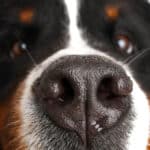
Home » The Essence of TYPE | Part 3 – Soft Coated Wheaten Terrier Coat and Color
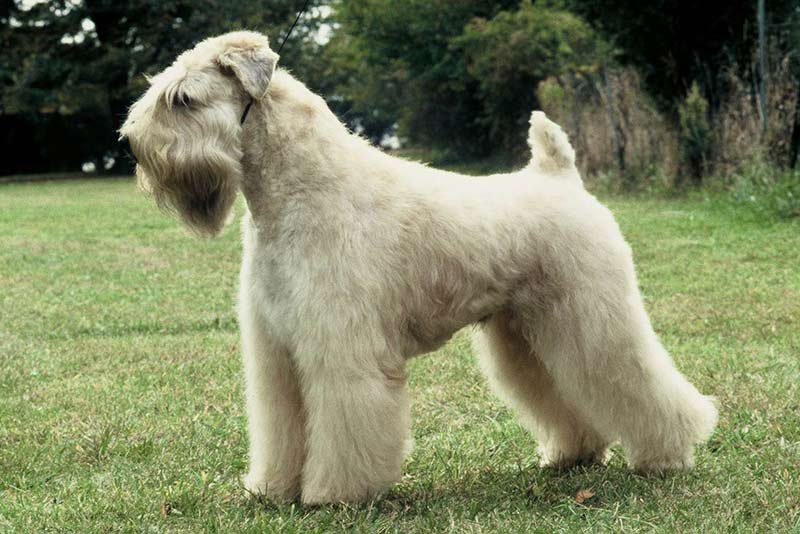
The Essence of TYPE | Part 3 – Soft Coated Wheaten Terrier Coat and Color | Essence–“the intrinsic nature of something; the quality which determines something’s character” (Oxford University Press)
The essence of breed type can be defined as how the various parts of a dog come together with the requisite temperament to make a breed unique.
In my previous two articles on Soft Coated Wheaten Terrier type, I described proper silhouette and head properties. This article will not be a primer on Wheaten coat (that might be a chapter rather than an article*); instead, I will attempt to explain the relationship between proper coat and breed type. In other words, which coat factors contribute to the uniquely Soft Coated Wheaten “look?”
While Mrs. Holmes goes out of her way to decry overly abundant coats, thin coats where skin is readily visible are equally faulty. One key factor is undercoat. Ideally, the coat is single and abundant. Some dogs do carry single coats throughout their lives, while others start out with undercoat that intensifies during adolescence and then dissipates with maturity, resulting in single-coated adults.
Our standard states, “An abundant single coat… Texture soft and silky with a gentle wave.” Color is described as “any shade of Wheaten” and goes on to describe guard hairs of different colors and the characteristic darker mask. However, there is a range of acceptable coat textures and colors. In fact, while still remaining “typey,” many Wheatens go through continual changes in coat and color. In an attempt to categorize coats, breeders often use the terms “Irish,” “American,” “Continental,” etc., but I will attempt to discuss coat without geographic designation. Too often the terms are used pejoratively, and coat texture and color are controlled by heredity not birthplace. Geographic differences in coat variations reflect selective breeding. I will discuss coat and color separately, but the two actually go hand in hand. Proper color generally reflects (pun intended) proper texture as the requisite shine is due to the quality of the individual hair shaft. (For an excellent discussion of this phenomenon, see: “What Makes for Colors and Coat Texture in Yorkies,” by Janet Bennett. Benchmarks, Volume 7, No. 2, Spring, 1979)
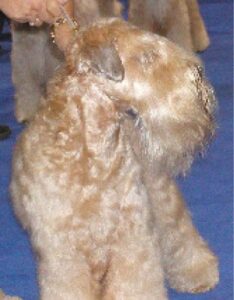 Both the AKC and the FCI standards will be quoted as well as the SCWTCA Illustrated Standard; while we must adhere to the requisites of the AKC standard, the FCI standard represents the edicts of the country of origin—Ireland. To view the standards, go to www.akc.org, www.fci.be. For a copy of the Illustrated Standard, go to the SCWTCA website at www.scwtca.org.
Both the AKC and the FCI standards will be quoted as well as the SCWTCA Illustrated Standard; while we must adhere to the requisites of the AKC standard, the FCI standard represents the edicts of the country of origin—Ireland. To view the standards, go to www.akc.org, www.fci.be. For a copy of the Illustrated Standard, go to the SCWTCA website at www.scwtca.org.
The most desirable coats are soft, silky, abundant, wavy, and single. Maureen Holmes, in her book, The Softcoated Wheaten Terrier, (“Printed by Racmo, Meppel; 1991, page 152-153) sums it up well, stating, “coat… must be soft and silky to the touch, wavy or curly, NOT Coarse… The coat must have body and be shiny. IT IS NEVER TO BE WOOLY. Thick, white, wooly, straight hair or stand-off coat are serious deviations as is a frizzy coat.” Since the American standard states that the coat is to fall in “gentle waves,” I take exception to the inclusion of the word “curly” in describing the ideal coat. In fact, in the original Irish standard it was specified that coat “…if curly, curls must be large and loose.” (Redlich, Anna The Dogs Of Ireland. Dundalk, Ireland; Dundalgan Press, 1949, page 166). Note that Mrs. Holmes uses the word “body.” This is important to our discussion, as the amount of coat that Wheatens carry has a tremendous impact on their appearance. While Mrs. Holmes goes out of her way to decry overly abundant coats, thin coats where skin is readily visible are equally faulty. One key factor is undercoat. Ideally, the coat is single and abundant. Some dogs do carry single coats throughout their lives, while others start out with undercoat that intensifies during adolescence and then dissipates with maturity, resulting in single-coated adults. It’s remarkable that such divergent puppy coats actually mature into very similar adult coats. Both the American and the FCI standards allow latitude when assessing coat texture in young dogs. However, the ideal coat will be wavy, abundant, and soft, even at six months.

The American standard mentions guard hairs only in the color section but, in the past, many adolescent Wheatens’ coats contained harsh guard hairs (the infamous “dead reds”). Today, many dogs sport coats where any guard hairs that do appear are soft, so this is the ideal for which we should be striving.
Unacceptable coat qualities include: coarse, wooly, frizzy, and/or plush. All of these factors produce a “stuffed animal” look. An overabundance of coat is caused by the presence of undercoat and produces a look that is foreign to correct breed type. On the other hand, too little coat is as faulty as too much coat. To be typey, Wheatens must be well-covered with coat. All the standards and amplifications agree on this.
Adult Wheaten coats must never be straight or tightly curled. Fortunately, the fashion of blow-drying (and even ironing) Wheaten coats has been replaced by air-drying, which enhances the coats’ natural waves. While “straight” is pretty self-explanatory, a distinction should be made between “waves” (gentle undulations) and “curls” (ringlets). Any sign of kink in the coat is particularly offensive.
I see the breed coming full circle in terms of coat quality, and if there can be any semblance of a silver lining behind the ominous kidney cloud, I think the rash of imports have not only improved coat quality, but also re-adjusted our eyes to the look of correct and typical coat. We can only hope that, just as it has become nearly impossible to finish a Wheaten with a curly, frizzy coat, in the future, the other undesirable coat qualities (harsh, wooly, overabundant, straight) will become nearly extinct as well.
Our (American) standard calls for “any shade of Wheaten.” The FCI standard is a little more specific, stipulating color must be: “A good, clear wheaten of shades from light wheaten to a golden reddish hue.” In the American standard amplification, proper color is described as “…any shade of Wheaten from pale gold through warm honey” (Illustrated Standard, page 26). Sometimes, proper coat casts a platinum-like sheen. Mrs. Holmes refers to this phenomenon saying, “… over this [coat] is a ‘silver sheen’ characteristic of the breed.” (Ibid. page 152.)
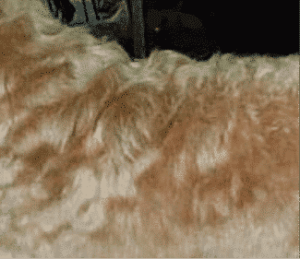 Correct color should be thought of as falling within a range of acceptable hues. The American standard amplification reminds us, “Very deep color in a puppy does not always predict strong adult color. Color change continues throughout the life of the dog. The hairs are often banded. Closely observed, the Wheaten is not a self-colored dog. (Illustrated Standard, page 26.) Both the American and FCI standards go into detail about puppy coats. However, the FCI describes newborn puppy colors, which would be nearly—if not entirely—cleared by the time they entered the ring. Our standard devotes a paragraph to the color transition that some coats make between six months and two years of age. While we still do see many Wheatens’ coats that go through the described transition, increasingly, many do not.
Correct color should be thought of as falling within a range of acceptable hues. The American standard amplification reminds us, “Very deep color in a puppy does not always predict strong adult color. Color change continues throughout the life of the dog. The hairs are often banded. Closely observed, the Wheaten is not a self-colored dog. (Illustrated Standard, page 26.) Both the American and FCI standards go into detail about puppy coats. However, the FCI describes newborn puppy colors, which would be nearly—if not entirely—cleared by the time they entered the ring. Our standard devotes a paragraph to the color transition that some coats make between six months and two years of age. While we still do see many Wheatens’ coats that go through the described transition, increasingly, many do not.
Most importantly, coat color must always be warm and reflective, which is dependent upon proper coat texture. (See photos above.) Again, proper coat texture creates correct color; you will never see ideal color on an improperly textured coat, as it will not carry the requisite sheen. Mrs. Holmes is quite adamant in stating “coat color… must have a warm GOLDEN hue NOT yellow…Brown is a colour that is NEVER mentioned or allowed in a WHEATEN … No black or gray is allowed in the adult coat, which includes the head.” (Ibid. page 153.) She singles out the head because it is not uncommon to find grey shading, allowed on ears and muzzle, spilling over onto the head. She goes on to say, “A white or pale coat must also be penalized.” (Ibid. page 153.) I would take exception to faulting a “pale” coat. If it has shine and is not white, I would call it acceptable—far more acceptable than a dull, oatmeal or grayish hue.
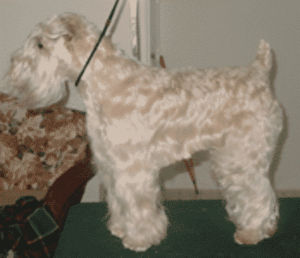 Historically, trimming has been a point of contention both here and abroad, but presently, I don’t consider it a problem here. A general discussion of presentation is outside the parameters of this article, but it can affect breed type when improper presentation creates an uncharacteristic look. While the FCI standard still allows for untrimmed dogs (which is rarely seen abroad), the American standard only describes trimmed dogs, cautioning that “Dogs that are overly trimmed shall be severely penalized.” Wheatens’ coats should never be cut as close as our Kerry Blue cousins. But, most often, when dogs appear to be over-groomed, it is the byproduct of poor coat quality and not overworked scissors. As noted above, the cessation of blow-drying and ironing of coats has greatly contributed to the uniformity of proper wavy coats seen in the ring today.
Historically, trimming has been a point of contention both here and abroad, but presently, I don’t consider it a problem here. A general discussion of presentation is outside the parameters of this article, but it can affect breed type when improper presentation creates an uncharacteristic look. While the FCI standard still allows for untrimmed dogs (which is rarely seen abroad), the American standard only describes trimmed dogs, cautioning that “Dogs that are overly trimmed shall be severely penalized.” Wheatens’ coats should never be cut as close as our Kerry Blue cousins. But, most often, when dogs appear to be over-groomed, it is the byproduct of poor coat quality and not overworked scissors. As noted above, the cessation of blow-drying and ironing of coats has greatly contributed to the uniformity of proper wavy coats seen in the ring today.
Can an otherwise excellent Soft Coated Wheaten with a bad coat be considered excellent? No! Can an excellent coat make an otherwise mediocre Soft Coated Wheaten excellent? No! Proper coat is only one important component and must never be championed above the whole dog. Accompanying photos depict ideal coat color and texture.
Proper coat is only one important component and must never be championed above the whole dog.
*For an excellent in-depth discussion of coat, see Kickie Norrby’s Evaluating Coat in the Wheaten Terrier. Also, note color photos of Wheaten Terrier coat in Maureen Holmes’ book The Soft Coated Wheaten Terrier, pages 155 & 156.
